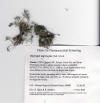|
Oxytropis campestris |
Oxytropis nigrescens |
|
Ralphs M. H., R. Creamer, D. Baucom, D. R. Gardner, S. L. Welsh, J. D. Graham, C. Hart, D. Cook and B. L. Stegelmeier. 2008. Relationship Between the Endophyte Embellisia spp. and the Toxic Alkaloid Swainsonine in Major Locoweed Species (Astragalus and Oxytropis). J. Chem. Ecol. 34(1):1–7. “Locoweeds (Astragalus and Oxytropis spp. that contain the toxic alkaloid swainsonine) cause widespread poisoning of livestock on western rangelands. There are 354 species of Astragalus and 22 species of Oxytropis in the US and Canada. Recently, a fungal endophyte, Embellisia spp., was isolated from Astragalus and Oxytropis spp. and shown to produce swainsonine. We conducted a survey of the major locoweeds from areas where locoweed poisoning has occurred to verify the presence of the endophyte and to relate endophyte infection with swainsonine concentrations. Species found to contain the fungal endophyte and produce substantial amounts of swainsonine were A. wootoni, A. pubentissimus, A. mollissimus, A. lentiginosus, and O. sericea. Astragalus species generally had higher concentrations of swainsonine than Oxytropis. Swainsonine was not detected in A. alpinus, A. cibarius, A. coltonii, A. filipes, or O. campestris. The endophyte could not be cultured from A. mollissimus var. thompsonii or A. amphioxys, but was detected by polymerase chain reaction, and only 30% of these samples contained trace levels of swainsonine. Further research is necessary to determine if the endophyte is able to colonize these and other species of Astragalus and Oxytropis and determine environmental influences on its growth and synthesis of swainsonine.”
|
|

